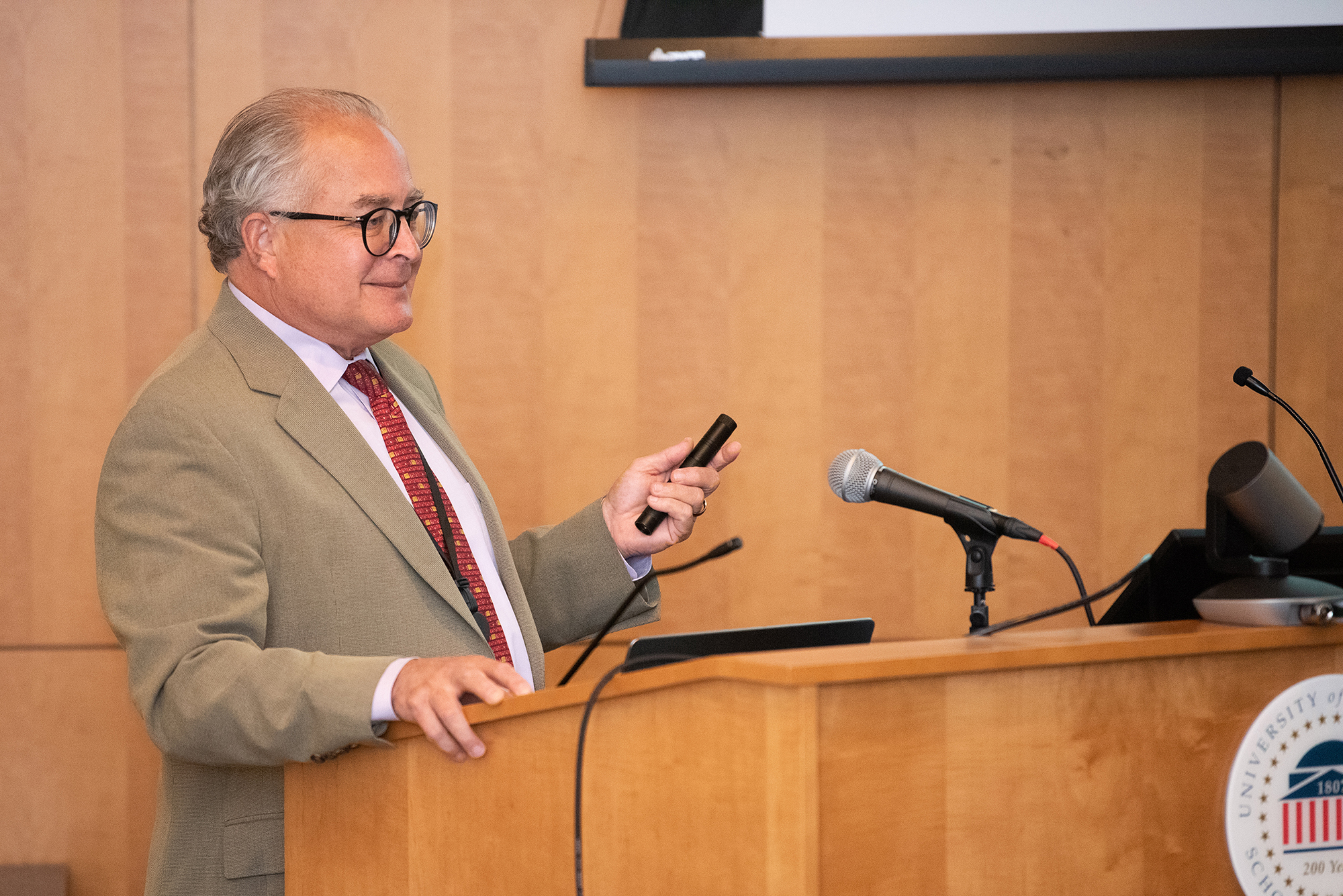Entrepreneur of Year Discusses Development of Artificial Blood
October 26, 2022 Lou Cortina
Allan Doctor, MD, delivers his Founders Week David J. Ramsay Entrepreneur of the Year Presentation, “Surmounting Challenges to Therapeutic Development with Bio-Inspired Design and Team Science.”
Allan Doctor, MD, delivered his University of Maryland, Baltimore (UMB) David J. Ramsay Entrepreneur of the Year presentation to a hybrid audience Oct. 24, detailing his research on developing artificial red blood cells and associated commercialization pursuits with KaloCyte, Inc.
Doctor’s presentation, part of UMB’s Founders Week events, was titled “Surmounting Challenges to Therapeutic Development with Bio-Inspired Design and Team Science” and held at the University of Maryland School of Medicine’s (UMSOM) Health Sciences Research Facility II.
(Watch a video of the presentation below and read more about Doctor at this link.)
Doctor, a professor in the Department of Pediatrics and director of the Center for Blood Oxygen Transport and Hemostasis at UMSOM, is the co-founder and chief scientific officer of KaloCyte, which is working to develop ErythroMer, a dried, bio-inspired artificial red blood cell designed to help clinicians treat life-threatening blood loss when red blood cells are unavailable, undesirable, or in short supply. He moved his research enterprise from the Washington University School of Medicine in St. Louis to UMSOM and the company to the University of Maryland BioPark in 2019.
“It’s taken a pretty extensive team to deal with the many challenges associated with creating fake blood,” said Doctor, acknowledging his KaloCyte colleagues including president and CEO Elaine Haynes, MBA, who was in attendance. “We have conceived, as a group, the approach to making it, how it works, the approach to dealing with the Food and Drug Administration [FDA], and finally the pathway to commercialization.”
UMB President Bruce E. Jarrell, MD, FACS, who could not attend because of another commitment, praised Doctor in his videotaped remarks to open the event, noting that the award is named after one of his predecessors as UMB leader, the late David J. Ramsay, DM, DPhil.
“Dr. Ramsay was a fierce advocate for entrepreneurism and the force behind the creation of the UMB BioPark. His creativity and persistence live even today on this campus through this award,” Jarrell said. “Dr. Doctor, this is a great accomplishment. Since the day you walked into UMB, your presence has been felt, your deep research has been appreciated, and your commitment to entrepreneurialism is always palpable.”
Mark T. Gladwin, MD, dean of UMSOM and vice president for medical affairs for UMB, introduced Doctor, noting that they share “many passions in science and medicine as well as passions for nitric oxide biology and signaling, hemoglobin, sickle cell disease, red blood cells, and hemoglobin-based oxygen carriers.
“Dr. Doctor has published more than 180 manuscripts and has an h-index of about 50, which means 50 of his papers have been cited more than 50 times — very remarkable. He’s been cited more than 10,000 times and has 11 patents related to his work. His particular focus, of course, is the development of a holy grail in the field of medicine: artificial blood substitutes. We are absolutely delighted that he moved here from St. Louis, and I am incredibly impressed with his vision and leadership.”
During his presentation, Doctor reviewed the history of blood substitute development and the physiologic basis for the safety concerns that prompted the FDA to deny approval for the “first-generation” products.
He described next-generation approaches to blood substitute development and the use of bio-inspired design as a strategic approach to surmount the safety concerns, in particular the application of novel synthetic chemistry and nano-formulation — which are the basis of the ErythroMer technology platform.
Doctor also reviewed the current performance evaluation of ErythroMer, its potential utility for out-of-hospital transfusion when blood is not available, and plans to extend its utility beyond that of “natural” red blood cells.
In his 56-slide, 45-minute presentation, he touched on design parameters for the ideal therapeutic, relevant physiology of the targeted system, design solutions, approach to fabrication, performance evaluation, regulatory approach, and pathway to commercialization — hoping to be performing clinical trials between 2024 and 2028.